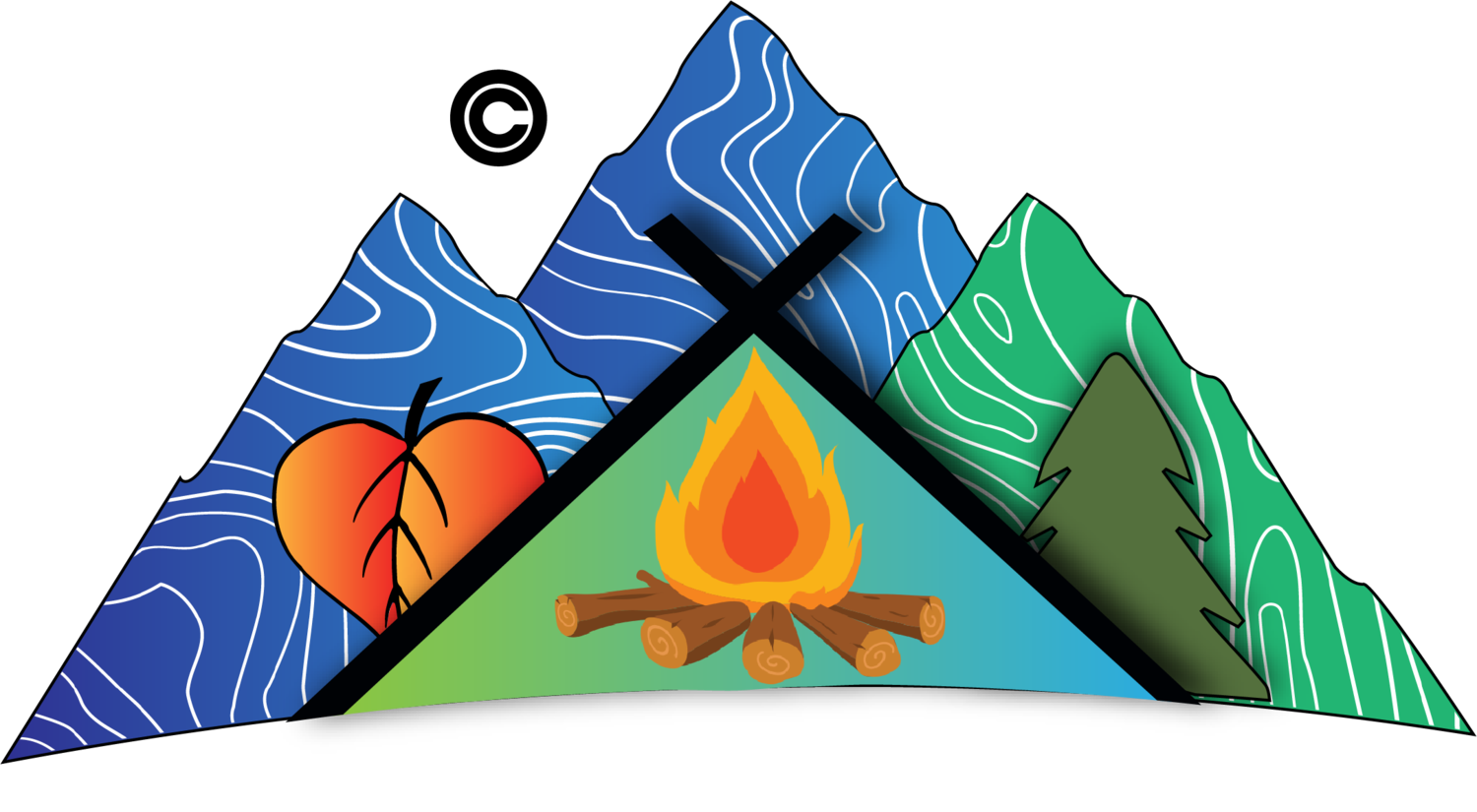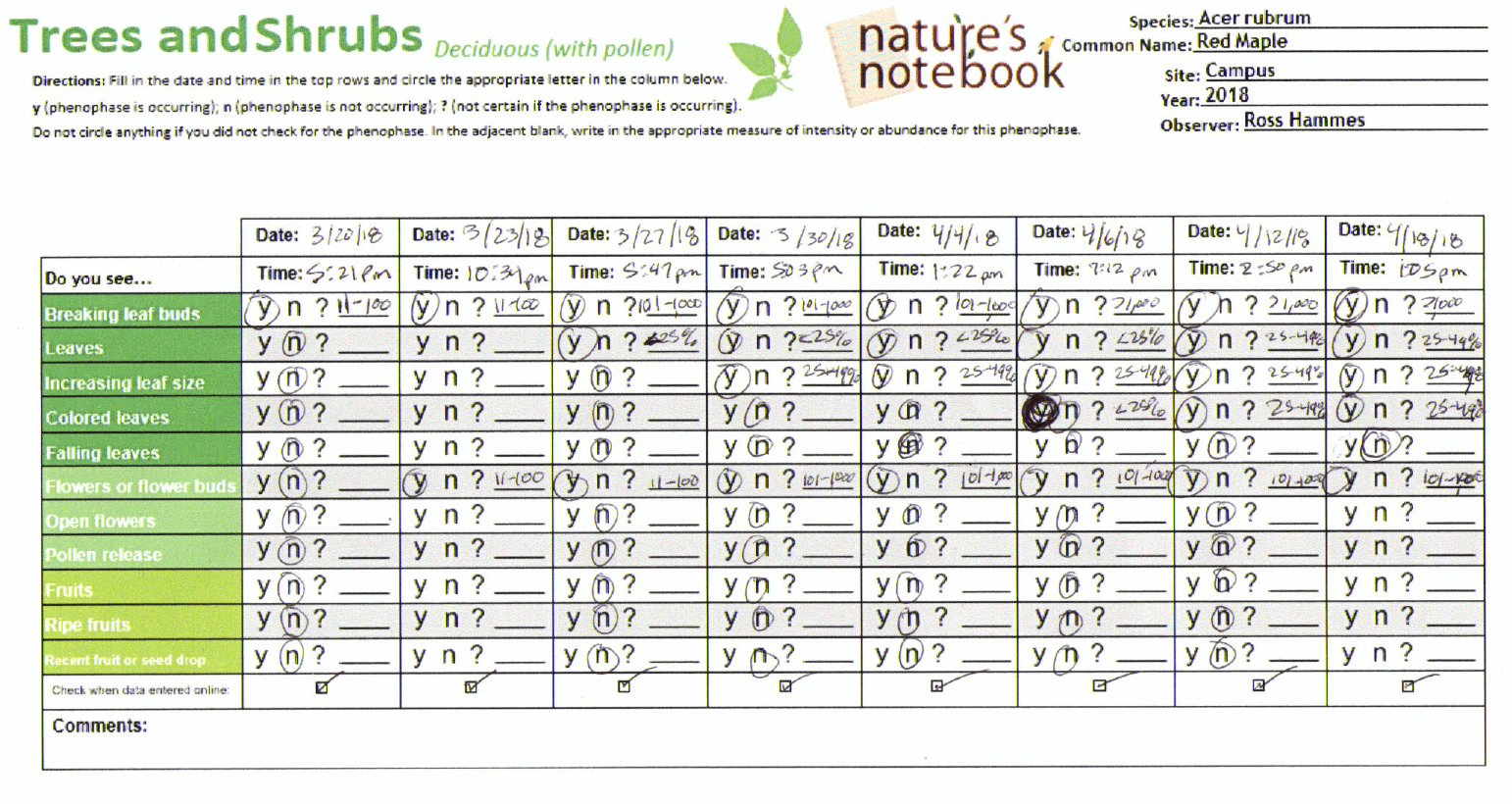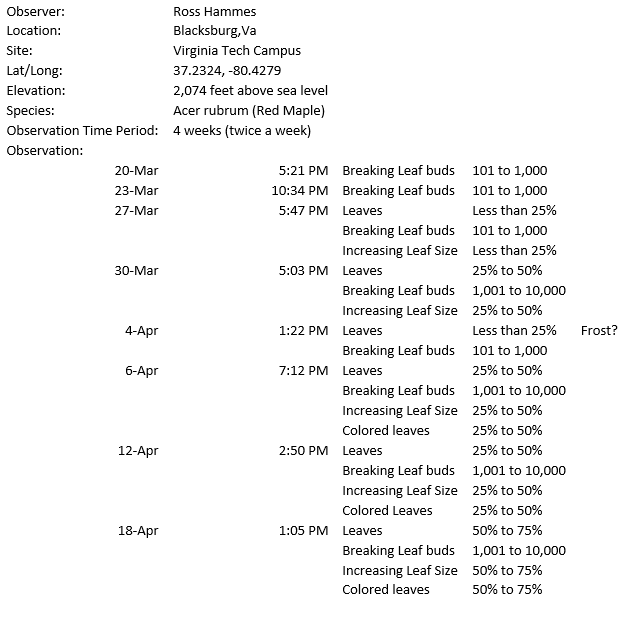"Nature's Notebook is a national, online citizen science program by the USA National Phenological Network where amateur and professional naturalists regularly record observations of plants and animals to generate long-term data sets used for scientific discovery and decision-making."
See URL: https://www.usanpn.org/natures_notebook
Introduction:
This CitSci project deals more with understanding natural systems using Nature's Notebook to contribute to a global geo-referenced data set of phenological phase changes which can be collected by anyone with access to a personal or shared computer for final data entry. A phenophase can be described as a change in a plants structure or in other words, the occurrence of leaves and/or flower including when they first appear. This is often times hard to determine unless the plant or tree species is observed on a regular basis so that data may begin to tell a story of when the observed species began to take change due to seasonality. The change is inhibited by photosynthetic activity which define the start, end and length of growing season for that specific tree species for that specific site. It may be safe to extrapolate this to other trees sharing the same species that have similar site and structure gradients. Aside from specific tree species, this type of data acquisition by citizen scientists bridges a gap between society and science that is needed. It allows for broad spatial distribution, however, not as broad as remote sensing. This can be combined with other geospatial data across much larger areas to get the “big picture” regarding plant response to environmental change specifically climate change and seasonal variations. One drawback is that is does not give as much process knowledge as other extensive data products such as FIA data or intensive research from techniques such as phenocams or flux towers, etc (see Earth page; CeNRADS section for example).
Site Selection:
The site I selected is in the parking lot next to the parking garage on campus. I observed this tree for 4 weeks, about twice a week, using the “Nature’s Notebook” data collection sheet. The types of observations over the course of this one-month study period included prevalence of breaking leaf buds, leaves, colored leaves, fruiting and flowering as well as the size of these leaves and buds to show growth changes. The tree observed is the Acer rubrum or red maple which is considered a calibration species at the broad scale and is the most commonly collected tree species on NN. This tree can grow up to 90 feet tall and usually flowers mid to late April. It grows a dry fruit known as samara in the late spring to early summer. The tree I observed is about 20 feet tall so at an average growing rate of 1 to 2 feet per year, one can assume this tree is between 10 to 15 years old.
Intellectual Merit:
Phenology is the study of the start and end of seasons based on bud burst, blossoming, leaf change, etc. It has been even more closely studied in recent decades with the occurrence of climate change and the desire to further understand the effects of global warming. Along those lines, there is also a growing interest in understanding the urban heat island phenomena on plant and tree growth. Increased impervious surface cover associated with urban areas, increases the albedo thus trapping more radiation and causing earlier starts of the season. According to Dr. Carolyn Enquist at USANPN, this sort of program can be used to "define planning purpose and objectives, assess climate impacts and vulnerabilities, review conservation goals, identify adaptation options, evaluate and prioritize adaptation actions, and lastly, monitor effectiveness and ecological responses over time."
See URL: https://www.youtube.com/watchv=mQ17mkc39Ps&feature=youtu.be
In addition, projects like Nature's Notebook are a great asset to the scientific community and gets citizens involved and interested in these precious natural resources. Education is one of the greatest tools for conservation efforts and citizen science is one of the greatest ways to achieve this goal and should be introduced to children as much as Pokemon Go has. The app must be simple enough and make it to where the app achieves the most accurate depiction of the study with a precise location.
The project aims to achieve the following objectives:
1) Examine the conditions of a red maple tree in an localized, small, urban setting (Blacksburg). 2) Further assess this tree’s role in carbon sequestration. 3) Generate a trusting relationship among various stakeholders. 4) Expand and combine this data to other trees in this region all to understand seasonal weather variations which may be used to better understand the long-term effects from climate change.
Again, Nature’s Notebook is just one example of a popular CitSci program that allows people around cities to collect phenological observations to be used for the public's best interest. One interesting example of how this service can be used to enhance planning stems from the Cherry Blossom Festival in Japan held each spring. In this case it is used to choose the best start date of the festival. Once they get the sufficient observations and see a drastic increase in new buds they set the start of the festival. Without this service, the festival would be unsuccessful. The first bloom effects when events like the Cherry Blossom Festival will start in Kyoto, Japan. When the festivities are a celebration of the new blossoming of their beloved tree. The festival lasts a week and as the Cherry trees begin to blossom the entire city comes together to cherish the moment. Not only does it create unity in the community, but it is a huge economic booster as people from all parts of Japan and the world come together in the city.
Results:
The tree’s images, raw data, summarized data, and other related materials can be seen further down this thread. My data can be summarized into the following observations: 1) the first leaf bud had already broken by 3/20, my first day of collecting data. The weather was a relatively cold day with intermittent showers, 2) approximately a week later I began seeing some leaves, but still staying in the 50s most days so growth seemed very static. 3) This growth started to really spike a coupe days later where we entered a period of relatively nice weather in the 60s and 70s. 4) Lastly, a steady increase occurred a little over two weeks ago and the weather has stayed dry and warm with a few cold, rainy days mixed in. (I am clearly not a meteorologist!). With fair weather and increased precipitation over the last week, it is safe to say that spring has finally sprung, and these few April showers will hopefully bring May flowers which I can expect as I continue to observe this tree over the coming weeks. I will also add that my flowers are starting to really take off in my flower bed!
Program Review:
- Project design: From my understanding, Nature's Notebook is one of the most used crowd sourced phenological projects that is celebrating its tenth anniversary. I think the manager's have done an excellent job with limited resources to create such a wonderful tool that has so much potential to grow which I will expand on later. One of the biggest concerns is accuracy but NN provides an extensive set of tutorials for the more curious collector or just for someone new to the idea of it altogether. I think the most innovative part of this program is the ability to use one's smart phone to collect the observations. I for one had my book bag on me every time I passed this tree but for those not carrying one, the smart phone is widely owned by all age groups. The data is shared via a web portal with a linked interactive map and data dash board. This is becoming a more popular way to allow scientists to view and download data and for quick visual analysis of overall trends via a data dashboard. The focus is on communicating directly with other scientists and with the public.
- Participation journal: I did not need to do any prior training because the app was very straightforward and I have a good understanding of the program and need for it. I found the project to be interesting as it allows the user to connect to his natural surroundings and better understand the dynamic state of trees that most often gets overlooked. It was also very easy as this tree was on my way to class and allowed me to only slightly deviate from my usual bike route on campus. I do plan on continuing to visit my tree as it is fairly close to my house, therefore I will periodically check its progress and continue updating the observations and to also see its first flowering. Dates and times are located below.
- Public Outreach: The user experience was simple and straight forward. You can use an app on your phone or do it the old fashion way on paper, either way it is nice to be able to snap a photo. Unfortunately, the app does not allow you to save a picture with a picture ID so you have to do this after if you would like pictures as a record. This is something I would change. An example of the app can be seen further down this page. The goal of this project is collect data for scientific use and engage the public. Advertising is problematic should be the primary focus for Nature's Notebook but unfortunately, money is needed so deeper exploration into more attractive means to engagements end. Advertising should be the primary focus for Nature's Notebook but unfortunately, money is needed so deeper exploration into more attractive means to engagements end. Lastly, if I had any say-so in the project I would aim to make the app more engaging with the audience. Sometimes the easiest way to a more sustainable future is through the eyes of children and young adults wanting to get out more. In a world where nature is competing with technology, there must be a creative way to get kids outdoors and away from their video games or computer and back in the hands of Mother Nature. I would suggest implementing an augmented reality like game of all types of wild and interesting creatures representative of real plants and animals for children to seek out in areas that the app is most interested in the data collection. Make clues unlockable upon completing small data collection tasks for real plants and known animal locations for the better good. In a way it is like sending Nature's bird's around to bring something back to the nest. Again, of course all of this would cost an enormous amount of money and effort which is arguably the biggest caveat.
This is the sheet I used to collect my data.
Then I added it into Excel to be imported into Natures Notebook.
Then I summarized it for easier observation.
Here are the pictures I snapped for reference.
I won some badges! :-)
A screenshot of the app that can be used.







